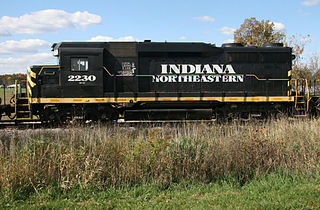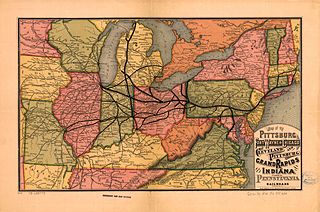
Railroads have been vital in the history of the population and trade of rough and finished goods in the state of Michigan. While some coastal settlements had previously existed, the population, commercial, and industrial growth of the state further bloomed with the establishment of the railroad.

The Indiana Northeastern Railroad is a Class III short line freight railroad operating on nearly 130 miles (210 km) in southern lower Michigan, northeast Indiana and northwest Ohio. The Indiana Northeastern Railroad Company began operations in December 1992 and is an independent privately owned company. As of 2017 the railroad hauled more than 7,000 carloads per year. Commodities moved by the railroad include corn, soybeans, wheat and flour. It also handles plastics, fiberboard, aluminum, copper, coal, perlite, stone, lumber, glass, rendering products, as well as agricultural fertilizers and chemicals.

The Mid-Michigan Railroad is a railroad owned by Genesee & Wyoming. It operates 39.8 miles of track in Michigan.

The Chicago, Kalamazoo and Saginaw Railway (CK&S), known informally as the "Cuss, Kick & Swear" is a defunct railroad which operated in southwest Michigan in the late 19th and early to mid 20th centuries. Despite the name, the line ran entirely within the state of Michigan, with the majority in Kalamazoo County. It eventually became part of the New York Central. As of 2010, most of the former CK&S tracks have since been abandoned.
The Saginaw and Mount Pleasant Railroad was a wholly owned subsidiary of the Flint and Pere Marquette Railroad (F&PM). It was established to construct a 14.7-mile (23.7 km) railway line from a junction with the F&PM main line at Coleman, Michigan, to Mount Pleasant, Michigan. The line opened on December 15, 1879, as a 3 ft narrow gauge line. In mid-1884 the line was converted to 4 ft 8+1⁄2 instandard gauge. On January 31, 1889 the company was formally merged into the F&PM along with the East Saginaw and St. Clair Railroad, the Saginaw and Clare County Railroad, and the Manistee Railroad.
The Flint River Railroad is a defunct railroad. It was established on December 6, 1871, to construct a 14.4-mile (23.2 km) branch from Horton to Otter Lake to support the logging industry in the Flint River area. This line was opened on October 8, 1872, and the company was consolidated with the Flint and Pere Marquette Railroad (F&PM). In 1881 the F&PM extended this line 5.2 miles (8.4 km) to Fostoria.
The Detroit, Lansing and Northern Railroad (DL&N) is a defunct railroad which was formed on December 27, 1876 as a reorganization of the foreclosed Detroit, Lansing and Lake Michigan Rail Road. The segment of its main line from Detroit to Lansing became an important component of the Pere Marquette Railroad, organized in 1900, and is still in use by CSX.
The Chicago and West Michigan Railway (C&WM) is a defunct railroad which operated in the state of Michigan between 1881 and 1899. It was one of the three companies which merged to become the Pere Marquette Railway.
The White River Railroad was a wholly owned subsidiary of the Chicago and West Michigan Railroad incorporated on November 13, 1879, for the purpose of constructing a rail link north from the C&WM's line at White Cloud to the Flint and Pere Marquette Railroad's main line (Ludington–Monroe) at Baldwin, and to exploit the ample timber resources of the White River area. On April 1, 1880, the White River opened a 13-mile (21 km) line from White Cloud north to Merrill Township, in Newaygo County. In 1881 the line was extended a further 4 miles (6.4 km) to what would become Bitely in 1889. In either late 1883 or no later than February 7, 1884, the White River completed the line all the way to Baldwin, for a total length of 29.86 miles (48.06 km).
The Patterson Railroad is a defunct railroad that existed in Michigan during the early 1870s. The company incorporated on September 21, 1870 and filed articles on October 3 to construct a line between Patterson Mills and Kiddville. The Patterson completed a 1.67-mile (2.69 km) in July 1872, at which point the property became part of the Detroit, Lansing and Lake Michigan Railroad, whose line it met at Kiddville. The DL&M would later become part of the Pere Marquette Railroad, which also built a line south from Belding.
The Toledo, Saginaw and Muskegon Railway is a defunct railroad incorporated in January, 1886. The railroad offered service between Ashley, Michigan and Muskegon, Michigan starting on August 1, 1888. The Grand Trunk Railway of Canada took control the same day, but the company did not merge with the Grand Trunk Western Railway until 1928.

The Mansfield, Coldwater and Lake Michigan Railroad (MCW&LM) is a defunct railroad which operated in southern Michigan and Ohio during the 1870s. By the time it went into foreclosure in the late 1870s it owned two non-contiguous track segments, each of which was leased by a different company.
The Michigan and Ohio Railroad is a defunct railroad which operated in southern Michigan in the mid-1880s. Originally intended to forge a new line from Lake Erie to Lake Michigan, it came close to its goal, completing a line between Allegan and Dundee before financial embarrassment landed it in receivership.
Michigan United Railways (MUR) was an interurban which owned and leased numerous lines in the state of Michigan during the early twentieth century.

The St. Joseph Valley Rail Road is a defunct railroad which operated in southern Michigan during the mid-19th century.
The St. Joseph Valley Railway (1889-1897), earlier known as the St. Joseph Valley Railroad (1880-1889), is a defunct railroad which operated in southern Michigan during the late 19th century. Intended to connect the Berrien County, Michigan communities of Buchanan and Berrien Springs with northern Indiana, the railroad never expanded beyond an initial connection between those two communities and sank under a weight of debt which poor traffic could not offset.
The Grand Rapids, Belding and Saginaw Railroad is a defunct railroad which operated in the state of Michigan at the turn of the 20th century.
The Leelanau Transit Company was a short line standard gauge railroad incorporated in 1919 as the successor to the Traverse City, Leelanau, and Manistique Railroad, which was incorporated in 1901 to build a line from Traverse City, Michigan to Northport, Michigan in order to support a carferry service to Manistique on the Upper Peninsula. This line was a project of the Grand Rapids and Indiana Railroad and completed a connection from Northport to the main north-south line at Walton Junction via the Traverse City Rail Road Company; unlike the latter, however, it was never folded into the parent company.
The Kalamazoo and White Pigeon Railroad (K&WP) was a shortline railroad in the U.S. state of Michigan. The line ran from Lansing to Jonesville, then returned north from Jonesville to Albion and Eaton Rapids before closing the loop in Lansing. The NCMR had a short life as an independent company, becoming part of the Lake Shore and Michigan Southern Railway in 1871 and then consolidating with the New York Central Railroad in 1914.





